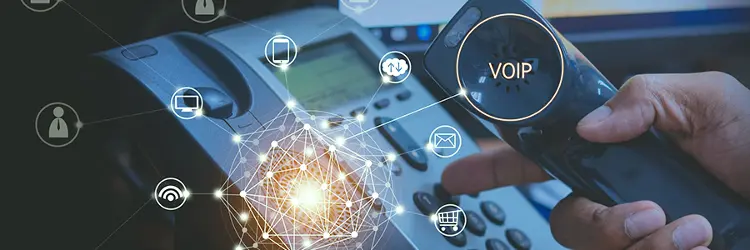VOIP Systems

VOIP Systems Installation & Configuration
VoIP (Voice over Internet Protocol) systems offer a cost-effective and feature-rich alternative to traditional phone... Read More
VoIP (Voice over Internet Protocol) systems offer a cost-effective and feature-rich alternative to traditional phone lines. They can enhance communication within your business by providing features like voicemail, auto-attendants, and multi-line capabilities. However, setting up a VoIP system can be complex, especially without a technical background.
Read lessGet Service
VOIP Systems Troubleshooting
Despite their convenience, VoIP systems can experience occasional issues. Here are some common... Read More
Despite their convenience, VoIP systems can experience occasional issues. Here are some common troubleshooting steps to get your VoIP system back on track:
- Basic Checks: Ensure your devices are powered on and properly connected.
- Network Connectivity: Verify your internet connection is stable and functioning.
- VoIP System Configuration: Double-check your VoIP system's settings for accuracy.
For more complex problems, consider seeking assistance from a qualified technician.
Read lessGet Service
Surveillance Systems

Surveillance System Installation and Configuration
Surveillance systems, often referred to as Closed-Circuit Television (CCTV), provide significant security... Read More
Surveillance systems, often referred to as Closed-Circuit Television (CCTV), provide significant security benefits for businesses. These systems typically include cameras, recording devices, and monitors, and their installation can be intricate.
The installation process typically involves several steps:
- Planning and Pre-Installation: Technicians collaborate with clients to review system blueprints and requirements. This includes determining equipment placement, cable routing, and power supply needs.
- Installation: Technicians physically install cameras, sensors, control panels, and wiring throughout the property. This may involve drilling, running cables through walls or ceilings, and mounting equipment securely.
- Configuration and Testing: Once equipment is in place, technicians configure the system software, set up recording parameters, and ensure all components function properly. This may involve testing cameras, alarms, and other functionalities.
- Training (Optional):In some cases, technicians may provide client training on using the system's features, such as live monitoring and video playback.
Get Service
Surveillance Systems
Troubleshooting
A functioning surveillance system is crucial for security. Here are some steps to troubleshoot common ... Read More
A functioning surveillance system is crucial for security. Here are some steps to troubleshoot common surveillance system problems::
- Basic Checks:Verify power supplies are functioning and connections are secure. Ensure you have the correct login credentials for accessing the system.
For more complex issues, consult the system's manual or contact a qualified technician.
Read lessGet Service
Surveillance Systems
Installation & Configuration
Surveillance systems, often referred to as CCTV, can provide significant security benefits for your business... Read More
Surveillance systems, often referred to as CCTV, can provide significant security benefits for your business.These systems typically include cameras, recording devices, and monitors, and can be quite complex to set up.
Tasks involved:
- Planning and Pre-Installation: Technicians review system blueprints and client requirements to determine equipment placement, cable routing, and power supply needs.
- Installation: They physically install cameras, sensors, control panels, and wiring throughout the property. This may involve drilling, running cables through walls or ceilings, and mounting equipment.
- Configuration and Testing: Once the equipment is in place, technicians configure the system software, set up recording parameters, and ensure all components function properly. This may involve testing cameras, alarms, and other functionalities.
- Training: In some cases, technicians may train clients on how to use the system, including features like live monitoring and video playback.
Get Service
SLA

VOIP Service Level Agreement (SLA)
A VOIP Service Level Agreement (SLA) is a formal contract between a client and a VoIP service provider... Read More
A VOIP Service Level Agreement (SLA) is a formal contract between a client and a VoIP service provider. It outlines the expected performance metrics of the VoIP system, ensuring consistent and reliable communication services. The SLA typically defines acceptable uptime percentages, call quality metrics (e.g., mean opinion score or MOS), and response times for troubleshooting and support. Read less
